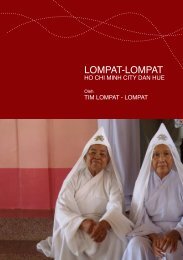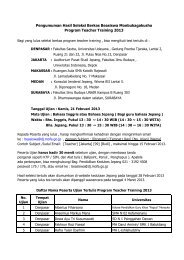9700_y16_sy
9700_y16_sy
9700_y16_sy
You also want an ePaper? Increase the reach of your titles
YUMPU automatically turns print PDFs into web optimized ePapers that Google loves.
Cambridge International AS and A Level Biology <strong>9700</strong> <strong>sy</strong>llabus Syllabus content<br />
8 Transport in mammals<br />
As animals become larger, more complex and more active, transport <strong>sy</strong>stems become essential to supply<br />
nutrients to, and remove waste from, individual cells. Mammals are far more active than plants and<br />
require much greater supplies of oxygen. This is transported by haemoglobin inside red blood cells.<br />
Candidates will be expected to use the knowledge gained in this section to solve problems in familiar and<br />
unfamiliar contexts.<br />
Learning outcomes<br />
Candidates should be able to:<br />
8.1 The circulatory <strong>sy</strong>stem<br />
The mammalian circulatory<br />
<strong>sy</strong>stem consists of a pump,<br />
many blood vessels and blood,<br />
which is a suspension of red<br />
blood cells and white blood<br />
cells in plasma.<br />
a) state that the mammalian circulatory <strong>sy</strong>stem is a closed double<br />
circulation consisting of a heart, blood vessels and blood<br />
b) observe and make plan diagrams of the structure of arteries,<br />
veins and capillaries using prepared slides and be able to<br />
recognise these vessels using the light microscope<br />
c) explain the relationship between the structure and function of<br />
arteries, veins and capillaries<br />
d) observe and draw the structure of red blood cells, monocytes,<br />
neutrophils and lymphocytes using prepared slides and<br />
photomicrographs<br />
e) state and explain the differences between blood, tissue fluid<br />
and lymph<br />
f) describe the role of haemoglobin in carrying oxygen and carbon<br />
dioxide with reference to the role of carbonic anhydrase, the<br />
formation of haemoglobinic acid and carbaminohaemoglobin<br />
(details of the chloride shift are not required)<br />
g) describe and explain the significance of the oxygen<br />
dissociation curves of adult oxyhaemoglobin at different carbon<br />
dioxide concentrations (the Bohr effect)<br />
h) describe and explain the significance of the increase in the red<br />
blood cell count of humans at high altitude<br />
8.2 The heart<br />
The mammalian heart is a<br />
double pump: the right side<br />
pumps blood at low pressure<br />
to the lungs and the left side<br />
pumps blood at high pressure<br />
to the rest of the body.<br />
a) describe the external and internal structure of the mammalian<br />
heart<br />
b) explain the differences in the thickness of the walls of the<br />
different chambers in terms of their functions with reference<br />
to resistance to flow<br />
c) describe the cardiac cycle (including blood pressure changes<br />
during <strong>sy</strong>stole and diastole)<br />
d) explain how heart action is initiated and controlled (reference<br />
should be made to the sinoatrial node, the atrioventricular<br />
node and the Purkyne tissue, but not to nervous and hormonal<br />
control)<br />
Back to contents page<br />
www.cie.org.uk/alevel<br />
27





